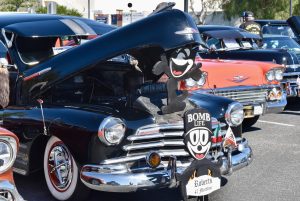10 car clubs from across Ventura County, Calif., gathered at California State University Channel Islands (CSU Channel Islands) to display their unique cars together, listen to music and have a good time. The “Lowriding in Ventura County” car show was held on Feb. 10, 2024, from 11 a.m to 4 p.m., with an accompanying photo exhibition by Johnny Lozoya, which ends March 15, 2024. The parking lot of El Dorado Park at CSU Channel Islands garnered not exclusively lowriders, but also classics, originals and even lowrider bikes. Cars of every color, shape and size occupied the lot, glittering in the midday sun as the members’ smiling faces shined brighter.

California lowrider culture began to rise in the ‘40s and ‘50s within Mexican communities in Southern California. To contrast the mainstream “hot-rods,” post-WWII Mexican car owners made theirs “low and slow,” by adding weights to the trunk for a sleek look. Cartoon characters like Mickey Mouse and Felix the Cat are popular amongst lowrider owners, and wooden or cardboard cutouts of characters are not uncommon to see. Flags — whether of Mexico, the United States or California — fly from antennas or grills. Coon tails are also a popular decoration that hang from the side view mirrors.
Lowriding culture was something entirely different from the mainstream car, incorporating a sense of individuality. Aside from the bright, colorful paint jobs, the cars often include patterns and designs reminiscent of Indigenous Mexican art; flowers, warriors, skulls and geometric shapes. Customized lowriders are a display of personality, creativity and ownership over heritage for Mexican communities.
In 1958, a new automotive law — California Vehicle Code 24008 — was introduced. It prohibited any part of the car to be below the bottom of its rims, which caused problems for the lowriding community. To combat this, hydraulics were commonly installed in lowriders to quickly raise/lower the frame.

Hydraulics soon became a staple in lowriding modifications. The most popular brand for lowriders is Chevrolet (Chevy) — cheap, in surplus and built with an “X” frame — because of their affordability and ability to easily modify. Now, models like the Chevy Impala are highly sought after.
Family is a word synonymous with car culture. For the lowriding community, it’s 10 percent cars and 90 percent people. Gerardo Jurado and Beth Mabry, members of City Life car club of Oxnard, Calif., own a Buick with a lineage. “It’s a family car … we always work on it,” Mabry said.
Despite mechanical issues or challenges Mabry and Jurado face, they work through them for the benefit of the car, and what it means to them. “We really love it and it’s our pride and joy,” Mabry said.
“On my license plate I put my mother’s name, La Gloria,” Rick Ricardez, owner of a glittery bronze Chevy El Camino said. Carried within his car are memories and a deep story. “We came over in a ‘59 station wagon from Kansas … gorgeous, hard-working, beautiful lady and I didn’t want her name just to vaporize,” he said, adding that now, “She’s riding in style.”

Ricardez also keeps a photo of his son, Andrew William Ricardez, on his dashboard. “My son rides with me wherever I go,” he said. “I lost my son … he made a negative decision in life … so I have a picture of [him] that’s always with me.”
Ricardez’s memory of his mother and son are able to live on through his lowrider.
Respect is another concept associated with the lowriding community. “There’s a culture where [everybody] respects the old classic cars,” Cathy Polzin, owner of a smooth green Chevy Chevelle, said. “Whether it’s a lowrider or an original, there’s just a lot of respect.”
For Polzin, a love of cars is hereditary. “I’ve always liked cars, ever since I was a little girl because my grandfather was really into them,” she said, adding that, “the people are great.”
Now, Polzin owns her very own classic car, which she bought in New York and was painted a gorgeous green by a Buena High School graduate.
The lowriding lifestyle is about more than just the cars; it’s about people, stories and culture. Every car is an expression of individuality while paying homage to Mexican heritage in a unique way.
This story was originally published on The Foothill Dragon Press on February 18, 2024.




































